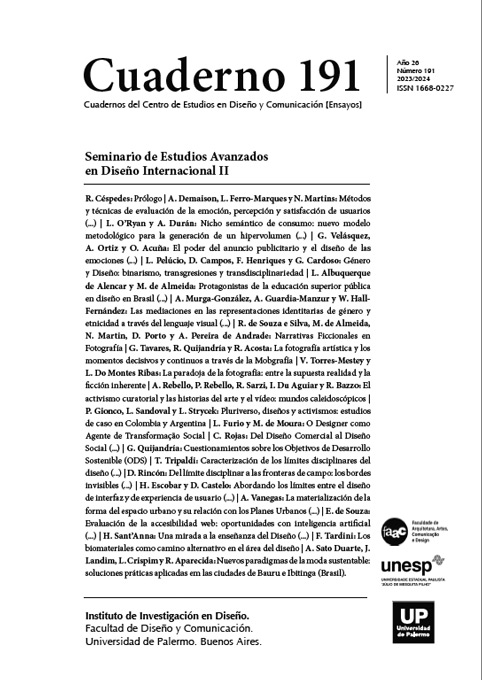Evaluación de la accesibilidad web: oportunidades con inteligencia artificial y aprendizaje automático
Resumen
La accesibilidad web es fundamental para la plena participación de las personas con o sin discapacidad en la sociedad. Sin embargo, la mayoría de los sitios no cumplen con los requisitos mínimos de accesibilidad.
Citas
Aizpurua, A., Arrue, M., & Harper, S., Vigo, M. (2014). Are Users the Gold Standard for Accessibility Evaluation? W4A’14 Proceedings. https://doi.org/10.1145/2596695.2596705
Antonelli, H. L., Sensiate, L., Watanabe, W. M., & de Mattos Fortes, R. P. (2019, October). Challenges of automatically evaluating rich internet applications accessibility. In Proceedings of the 37th ACM International Conference on the Design of Communication (pp. 1-6).
BigDataCorp, & Movimento Web para Todos. (2022). Acessibilidade na web brasileira | 4a edição. https://bigdatacorp.com.br/estudo-acessibilidade-na-web-brasileira-4a-edicao/
Brajnik, G., Yesilada, Y, & Harper, S. (2011). The Expertise Effect on Web Accessibility. Human–Computer Interaction, 2011, Volume 26. Taylor & Francis Group.
Disability Rights Commission (DRC). (2004). The web access and inclusion for disabled people: a formal investigation conducted by the Disability Rights Commission. London: TSO. https://disability-studies.leeds.ac.uk/wp-content/uploads/sites/40/library/DRCWeb-FI.pdf
Dogra, H. (2020). A Framework for an automatic evaluation of image description based on an image accessibility guideline (Master’s thesis, OsloMet-storbyuniversitetet).
Frug, S., & Bruce, T. (2019). Artificial Intelligence and Accessibility for Administrative Applications. In: Proceedings of the First Workshop on AI in the Administrative State.
Haider, W. (2021). Automatically Detecting Table Headings In Web Pages With Machine Learning (Master’s thesis, Middle East Technical University).
Hertzum, M., Jacobsen, N., & Molich, R. (2002). Usability inspections by groups of specialists: perceived agreement in spite of disparate observations. Proceedings of CHI ’02 (extended abstracts), pp. 662–663. ACM. https://doi.org/10.1145/506443.506534
Hornbeak, K., & Frokjear., E. (2008). A study of the evaluator effect in usability testing. Human-Computer Interaction, 23(3):251 – 277. https://doi.org/10.1080/07370020802278205 IBGE - Instituto Brasileiro de Geografia e Estatística. (2021). Pesquisa nacional de saúde: 2019: ciclos de vida. https://biblioteca.ibge.gov.br/visualizacao/livros/liv101846.pdf
International Organization for Standardization (ISO). (2008). Ergonomics of human-system interaction — Part 171: Guidance on software accessibility (ISO 9241-171). ISO. https://www.iso.org/standard/39080.html
Jacobsen, N., Hertzum, M., & John, B. (1998). The evaluator effect in usability tests. Proceedings of CHI ’98. ACM. https://doi.org/10.1145/286498.286737 Kavlakoglu, E. AI vs. Machine Learning vs. Deep Learning vs. Neural Networks: What’s the Difference? (2020, May 27). https://www.ibm.com/cloud/blog/ai-vs-machine-learningvs-deep-learning-vs-neural-networks
Kitchenham, B. A., Budgen, D., & Brereton, O. P. (2010, April). The value of mapping studies–A participant-observer case study. In 14th international conference on evaluation and assessment in software engineering (ease) (pp. 1-9).
Lopes, R., Gomes, D., & Carriço, L. (2010). Web not for all: a large scale study of web accessibility. Proceedings of the W4A’10. https://doi.org/10.1145/1805986.1806001 Meirelles, F. S. Panorama do Uso de TI no Brasil - 2022. (2022, May 26). Portal FGV. https://portal.fgv.br/artigos/panorama-uso-ti-brasil-2022
Morato, J., Campillo, A., Sanchez-Cuadrado, S., Iglesias, A., & Berrios, O. (2020, December). An Accessible Evaluation Tool to Detect Easy-To-Read Barriers. In 9th International Conference on Software Development and Technologies for Enhancing Accessibility and Fighting Info-exclusion (pp. 55-60).
Morillo, P., Chicaiza-Herrera, D., & Vallejo-Huanga, D. (2019, July). System of recommendation and automatic correction of web accessibility using artificial intelligence. In International Conference on Applied Human Factors and Ergonomics (pp. 479-489). Springer, Cham.
Organização das Nações Unidas. (2008). Convenção sobre os Direitos das Pessoas com Deficiência. https://www.un.org/development/desa/disabilities/convention-on-the-rights-ofpersons-with-disabilities/convention-on-the-rights-of-persons-with-disabilities-2.html
Petersen, K., Feldt, R., Mujtaba, S., & Mattsson, M. (2008, June). Systematic mapping studies in software engineering. In 12th International Conference on Evaluation and Assessment in Software Engineering (EASE) 12 (pp. 1-10).
Petersen, K., Vakkalanka, S., & Kuzniarz, L. (2015). Guidelines for conducting systematic mapping studies in software engineering: An update. Information and software technology, 64, 1-18. Power, C., Freire, A. P., Petrie, H., & Swallow, D. Guidelines are only half of the story: accessibility problems encountered by blind users on the web. CHI ‘12 Proceedings. https://doi.org/10.1145/2207676.2207736
Rodriguez, G. (2020). Improving Web Accessibility Through Suggestions Using Serverless Architecture (Doctoral dissertation, California State University, Northridge).
Russel, S.J., & Norvig, P. Artificial Intelligence: A Modern Approach. (2016). New Jersey: Prentice Hall.
Souza, Edson Rufino de. (2005). Anais do ATIID 2005. São Paulo: Prodam. http://www.prodam.sp.gov.br/multimidia/midia/cd_atiid/conteudo/atiid2005/mr2/02/avaliacaowebsite.pdf
Souza, Edson Rufino de, & Mont’Alvão, Claudia. (2012). Web accessibility: Evaluation of a website with different semi-automatic evaluation tools. Work, 41, 1567–1571. https://doi.org/10.3233/WOR-2012-0354-1567
Souza, Edson Rufino de. (2015). Avaliação da metodologia de conformidade com o Web Content Accessibility Guidelines (WCAG-EM 1.0) [Doutorado em Design, Pontifícia Universidade Católica do Rio de Janeiro]. https://www.dbd.puc-rio.br/pergamum/tesesabertas/1113325_2015_completo.pdf
Souza, Edson Rufino de. (2016). Acessibilidade web: diferentes definições e sua relação com o design universal. Diálogo com a Economia Criativa, v. 1, p. 13, 2016. http://dx.doi.org/10.22398/2525-2828.1113-28
Waller, S. & Clarkson, P. J. Tools for Inclusive Design. In: C. Stephanidis (Ed.). Universal Access Handbook. CRC Press.
WebAIM. (2022, March 31). The WebAIM Million - The 2022 report on the accessibility of the top 1,000,000 home pages. https://webaim.org/projects/million/
World Wide Web Consortium. Web content accessibility guidelines 2.0. 2008. http://www.w3.org/TR/WCAG20/.
World Wide Web Consortium. Web content accessibility guidelines 2.1. 2018. http://www. w3.org/TR/WCAG21/.
World Wide Web Consortium. Introduction to Web Accessibility. 2022. https://www.w3.org/ WAI/fundamentals/accessibility-intro/.
Yesilada, Y., Brajnik, G., & Harper, S. (2009). How Much Does Expertise Matter? A Barrier Walkthrough Study with Experts and Non-Experts. Assets’ 2009 Proceedings. https://doi.org/10.1145/1639642.1639678
Los autores/as que publiquen en esta revista ceden los derechos de autor y de publicación a "Cuadernos del Centro de Estudios de Diseño y Comunicación", Aceptando el registro de su trabajo bajo una licencia de atribución de Creative Commons, que permite a terceros utilizar lo publicado siempre que de el crédito pertinente a los autores y a esta revista.


